Accidental Assault: Girdled Trees
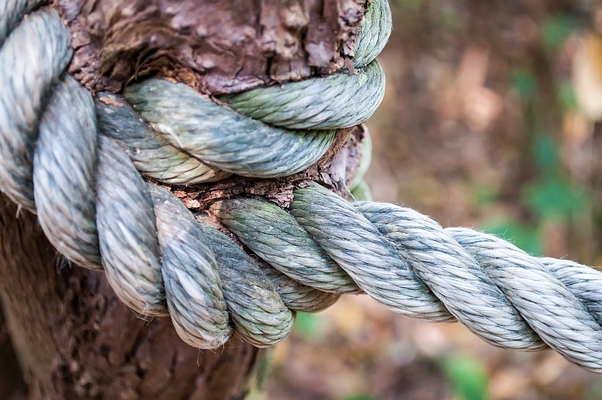
Understanding Tree Girdling
Tree girdling is a preventable yet common threat to the health of your trees. Girdling occurs when an object wraps around a tree branch or trunk, damaging the tree’s vascular tissue. Severe girdling often leads to the death of the affected branch, or in extreme cases, the entire tree.
Previously, we discussed girdling roots, which operate on similar principles. The main difference between girdling roots and accidental girdling lies in the cause. While girdling roots grow around the trunk, accidental girdling usually results from external items like stake wires and other forms of cordage tied to a tree.
Nature of the Problem
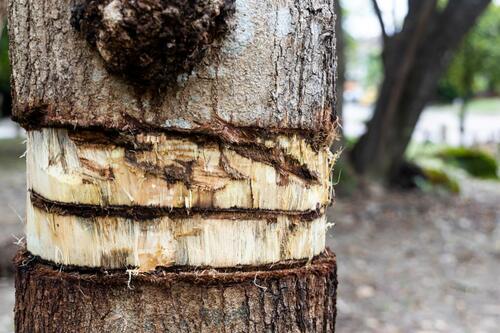
A Tree Trunk Damaged by Girdling
Trees transport water from their roots to their leaves via the xylem tissue. Conversely, sugars produced in the leaves are transported down the branches, through the trunk, and into the roots via the phloem tissue. This phloem tissue lies just inside the bark, outside the cambium layer, which separates the phloem from the xylem.
When an object tightly wraps around a trunk or branch, it can damage the phloem, preventing the movement of sugars. This stress causes the tree to decline and often leads to its death. The method is so effective at killing trees that it is sometimes used intentionally.
Common Offenders
Many trees are inadvertently girdled by human activities. Someone ties something to a branch or trunk, forgets to remove it, and ends up harming the tree. Despite being a practice to avoid, it is common due to trees being convenient anchors for items like clotheslines and rope swings. Here are some common applications that lead to girdled trees:
Tree Staking
Tree staking, or guying, involves attaching a stake to a flexible cord wrapped around a tree’s trunk to stabilize and protect it. While staking can be beneficial in some cases, improperly applied cords can girdle the tree. Proper application and regular inspection are crucial to prevent injury. Stakes should be removed after no more than one year and inspected every three to four months.
Tree staking is particularly common with newly planted trees that need extra support. However, many homeowners forget to remove the stakes or check the cords, leading to girdling as the tree grows and the cords become tighter.
Swings and Other Hanging Items
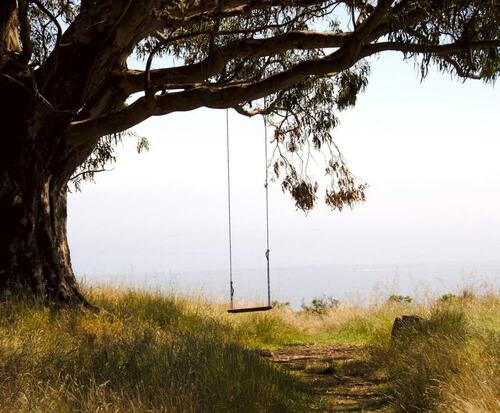
An Oceanside Tree Swing Tied to a Large Branch - Photo by Luke Chui on Unsplash
Trees can serve as anchor points for swings and other hanging items. To prevent girdling, attach these items in a way that minimizes damage. Periodically move the suspended item to different locations to allow the tree to heal, and cushion the attachment point with soft materials.
Children’s swings, hammocks, and even bird feeders are popular items to hang on tree branches. While these can be delightful additions to your garden, they must be installed with care. Regular checks are essential to ensure the attachments are not causing harm as the tree grows.
Outdoor Decorations and Lighting
Decorative lights, especially around holidays, are often wrapped tightly around tree trunks and branches. If left in place for too long, they can girdle the tree. Using wide, soft ties and removing lights promptly after the holiday season can help prevent damage.
Clotheslines and Utility Cords
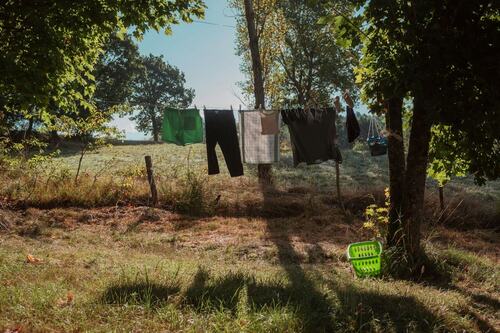
A Clothesline Strung Between Trees - Photo by Pauline Bernard on Unsplash
Many people use trees as anchors for clotheslines or utility cords. These items can easily be forgotten, causing prolonged pressure on the tree. Using adjustable fixtures and remembering to remove or loosen them regularly can prevent girdling.
Garden and Landscaping Materials
Gardeners sometimes tie plants or decorations to trees for support or aesthetic purposes. Materials like twine, wire, or plastic ties can girdle a tree if not monitored. Opting for biodegradable or adjustable ties and checking them periodically can mitigate this risk.
Unusual Items
Ropes, twines, and other forms of cordage can girdle a tree, but occasionally, other items like fences can cause similar damage. Trees growing too close to fences, especially barbed wire, can suffer as the tree’s growth pushes the wire into the bark. Partially girdled trees are more likely to fail. To avoid this, ensure fences and other items give nearby trees enough space. If a conflict is unavoidable, redesign the fence or proactively remove the tree.
Tree Guards and Protectors
Tree guards and protectors are used to shield young trees from animals and physical damage. However, if these guards are not properly maintained or removed as the tree grows, they can cause girdling. It is important to select appropriately sized guards and regularly check them to ensure they are not causing harm.
Preventative Measures
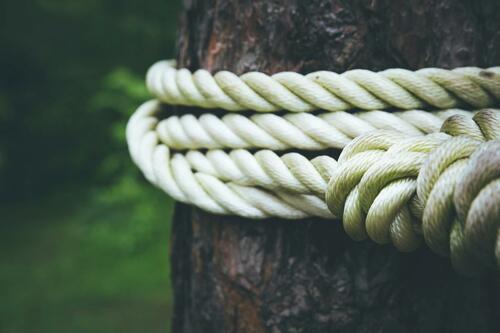
White Rope Tied Around a Tree Trunk - Photo by Markus Spiske on Unsplash
Preventing tree girdling involves regular inspection and maintenance. Ensure that no foreign objects are tightly wrapped around your trees. Here are several detailed steps you can take to keep your trees healthy:
Regular Inspection
Frequency: Inspect your trees at least once every three months. Pay special attention to trees with any attachments.
What to Look For: Check for any cords, wires, or objects wrapped around the trunk or branches. Look for signs of girdling, such as indentations in the bark or reduced foliage.
Action: Remove or adjust any items that may be causing harm. Ensure they are not tightly wrapped and allow space for growth.
Use Protective Materials
Soft Materials: When attaching anything to a tree, use soft, wide materials such as cloth straps or padded ties to distribute pressure evenly. Avoid using narrow, rigid materials like wire or thin rope, which can cut into the bark.
Adjustability: Use adjustable fixtures that can be loosened or moved as the tree grows. This flexibility can help prevent long-term damage.
Move Attachments Periodically
Why: Even with protective materials, prolonged pressure in one spot can cause damage over time.
How Often: Move attachments to different locations on the tree every few months. This practice allows the tree to heal and prevents continuous pressure in one area.
Give Trees Space
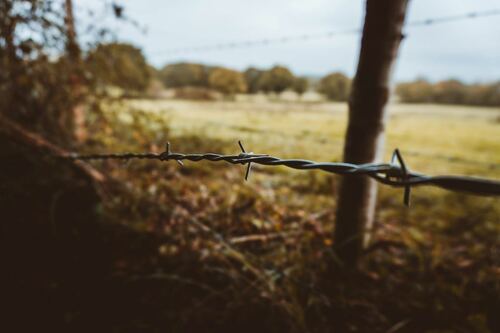
A Barbed-Wire Fence Near a Tree - Photo by Quentin on Unsplash
Fences and Structures: Ensure that fences, garden structures, and other items are placed at a safe distance from trees. This consideration is especially important for young trees that need space to grow.
Redesign If Necessary: If an existing structure is too close to a tree, consider redesigning the structure or relocating the tree. Proactive measures can prevent future conflicts and potential damage.
Educate and Communicate
Homeowners and Gardeners: Educate yourself and others about the risks of tree girdling. Share information with family members, neighbors, and anyone involved in garden maintenance.
Professional Advice: Consult with an arborist or tree care professional for guidance on proper tree care. Professional advice can be invaluable, especially for new homeowners or those unfamiliar with tree maintenance.
Protective Guards and Barriers
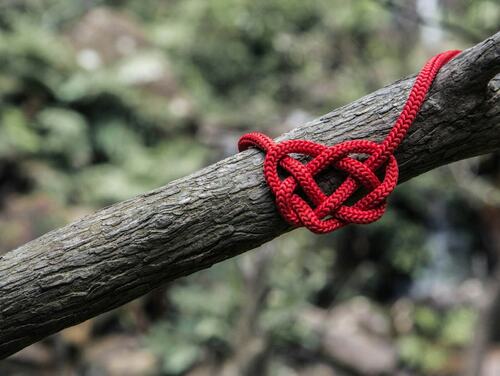
Tree Guards: Use tree guards to protect young trees from animals and physical damage. Ensure these guards are correctly sized and monitored regularly.
Barriers: Install barriers around the base of the tree to prevent animals or machinery from causing damage. Barriers can be particularly useful in areas with high foot traffic or in gardens with active pets.
Contact Arborist Now
For professional guidance on tree care and proper placement of new trees, do not hesitate to contact Arborist Now. We can help you avoid damaging your trees and ensure they remain healthy and vibrant.
By implementing these practices, you can protect your trees from accidental girdling and maintain a healthy landscape. Regular attention and care will ensure your trees thrive for years to come.
Originally posted in 2016.





